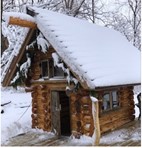This Agile success story is drawn from the experience report “When Life Gives You Derecho, Make a Log Cabin with Agility!” written by Kevin Sutherland.
In August 2020, a powerful storm tore through the Midwest, leaving destruction in its wake. Fallen trees and chaos surrounded Kevin Sutherland and his neighbors. But instead of just cleaning up, Kevin saw an opportunity: what if they could use those downed trees to build a log cabin?
This idea wasn’t just about repurposing the debris; it became a hands-on experiment in Agile principles that Kevin was also applying in his professional life.
The cabin project and his work projects shared the same spirit of adaptability, collaboration, and iterative improvement. Through both, Kevin discovered Agile wasn’t a checklist of steps but a flexible, values-driven approach that could shape any project, even one as unconventional as building a log cabin.
Rigid structures meet real-world complexity
Early obstacles in Agile practice

Kevin and his family started the cabin project without a formal plan, but they quickly found their rhythm by focusing on a few guiding principles. Meanwhile, at work, Kevin’s team encountered the opposite problem: a strict, process-heavy approach to Agile that often felt more restrictive than empowering.
Consequences of rigidity:
- The family initially struggled with limited tools and experience, while Kevin’s work team faced rigid roles that stifled collaboration.
- At work, the focus on ceremonies over outcomes slowed productivity and reduced engagement, making Agile feel like “just another process.”
- The team’s mechanical approach led to missed deadlines and a lack of alignment with customer needs.
Transformation through Agile values
The turning point for both projects came when Kevin began embracing Agile’s core values over rigid procedures. Agile became a way to respond to real needs with flexibility, creativity, and purpose.
Step 1: Setting a clear vision and purpose
For the cabin, Kevin’s family defined a simple vision: a cozy, natural retreat where they could enjoy time together. They set key criteria—weatherproofing, comfortable sleeping space—but left the details open to evolve as they went.
Similarly, Kevin encouraged his team to align on a vision that focused on customer needs rather than strict requirements, bringing clarity and purpose to their work.
Step 2: Embracing collaboration and trust
The cabin became a family project, with each member contributing ideas and labor. Kevin empowered them to make decisions, making it a shared experience.
At work, he applied the same principle, trusting his team to self-organize and collaborate beyond rigid roles. With trust came ownership, and each member brought their best ideas forward.
Step 3: Practicing adaptability and learning continuously
Without a set plan, the family constantly adapted, experimenting with different tools and techniques. Kevin learned through trial and error, refining his methods as he went.
At work, his team abandoned a rigid Scrum approach for a more flexible Kanban system, which allowed for real-time adjustments. Both projects became exercises in continuous learning, where each challenge revealed new insights.
Step 4: Focusing on value and customer experience
As they added features like LED lights and a creek-side deck to the cabin, the family focused on what would make the space truly enjoyable.
At work, Kevin’s team shifted focus to delivering features that directly addressed customer needs, ensuring every improvement was meaningful. Prioritizing value over strict plans allowed both projects to flourish.

Resolution and success
The transformation was clear. The cabin, which started as a rough idea, turned into a cherished retreat where Kevin’s family hosts movie nights and campouts. It wasn’t just a cabin—it was the product of creativity, adaptability, and shared effort.
Kevin’s work team saw similar results. By trusting in Agile’s core values, they improved workflow, reduced friction, and delivered high-quality work that delighted their customers.
- Stronger team dynamics: Both family and work teams grew closer, working together with trust and open communication.
- Greater productivity: Flexibility allowed both teams to work smarter, focusing on what mattered and adapting to changes.
- Customer satisfaction: A focus on value led to solutions that resonated deeply with both the family (as “users” of the cabin) and the organization’s customers.
Agile as a mindset, not a method
Building a cabin from storm-felled trees became a powerful metaphor for Agile’s adaptability and resilience. Kevin’s story shows that Agile isn’t about rigid frameworks but a mindset focused on purpose, flexibility, and continuous improvement. For any team or individual, Agile can be a guiding philosophy that adapts to their unique needs.
When you focus on purpose, trust your team, and remain open to learning, you’re practicing Agile in its truest form. Just as Kevin’s family turned the chaos of a storm into a space of warmth and connection, Agile helps teams turn uncertainty into meaningful, impactful outcomes.
Read the original experience report “When Life Gives You Derecho, Make a Log Cabin with Agility!” by Kevin Sutherland.









